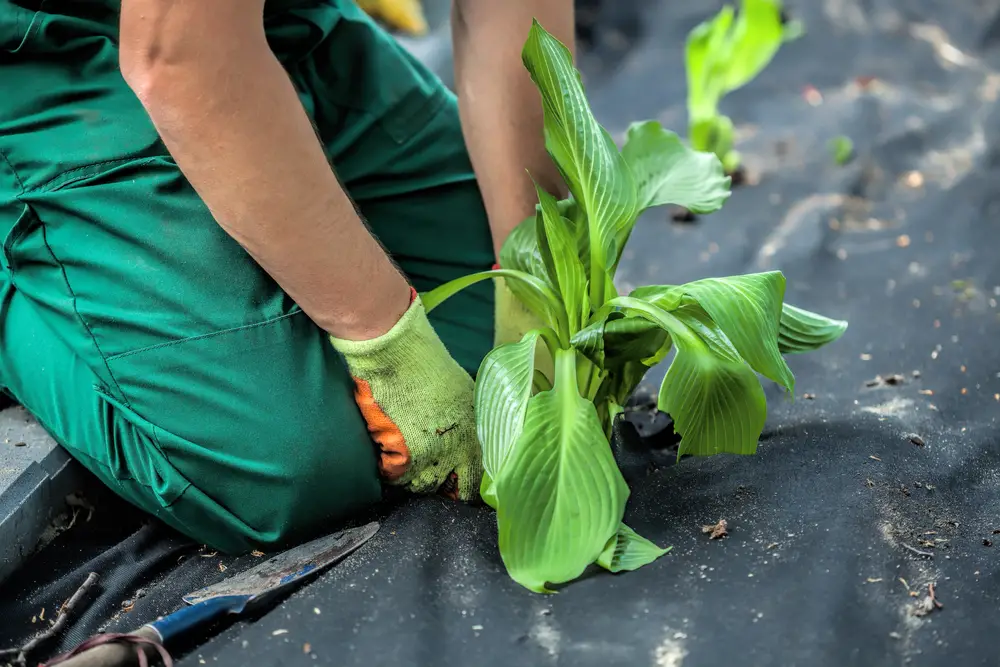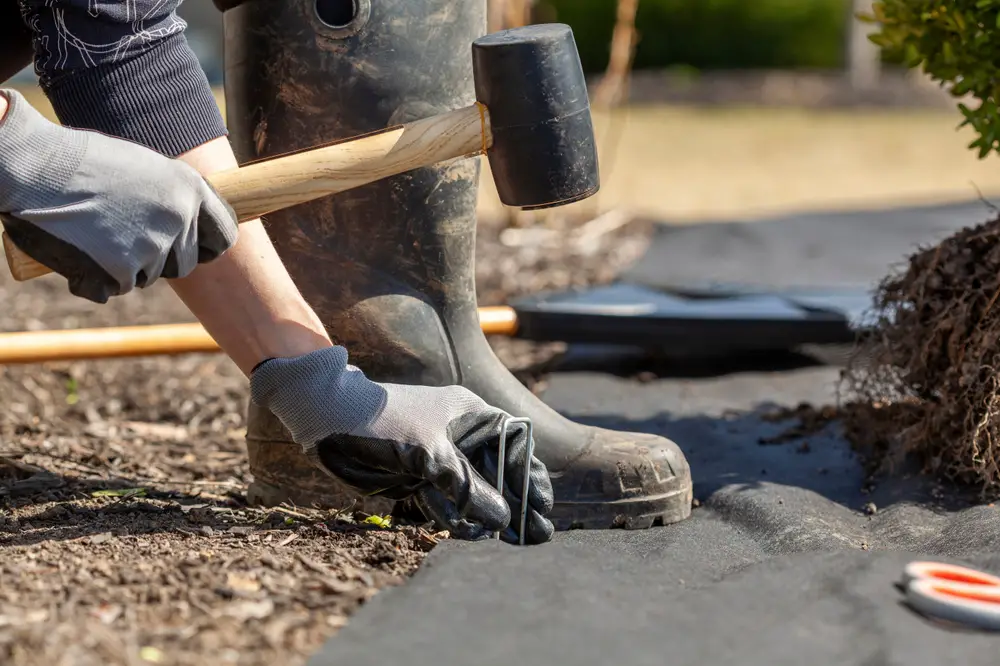Manufacturers market landscape fabric (or weed barrier) as a great solution to reduce or even prevent weed growth in your garden in the long term. And who wouldn’t love to avoid pulling weeds?
Unfortunately, if you haven’t had the “pleasure” of using landscape fabric before, you won’t know the regret that comes with it.
It’s not all bad, of course, as it does have some minimal uses, but it will ultimately cause more problems than it solves.
It does have some pros, though, which is where we’ll start.
Pros

We generally don’t recommend using landscape fabric on ornamental garden beds, but it does have limited uses for planting annuals or vegetables for one growing season. It also has some limited uses for pathways and decorative features.
Let’s start with short-term weed reduction.
Short-Term Weed Reduction
Landscape fabric blocks sunlight and prevents the growth of weed seeds in your soil. This can be useful when planting annuals or vegetables.
In this case, you use the fabric for one season, then remove it from your garden bed. As you’ll see more in the Cons section, there are good reasons you want to remove the fabric as soon as possible.
Extending Your Growing Season By Warming The Soil
Landscape fabric is black. It absorbs and traps heat from the sun and warms up the soil underneath it. This can be useful in the springtime to warm up the soil more quickly and get a headstart on the growing season for annuals and vegetables.
Loss Prevention Of Inorganic Mulches In Decorative Garden Features
You can use landscape fabric when installing permanent decorative features like dry river beds. In that case, you lay the fabric down and put river rocks and stones on top. The fabric prevents the rocks and stones from sinking into the soil over time.
It’s Useful For Quick And Easy Pathways
In this case, it’s best to use heavier woven plastic varieties, which are more durable and often chemically treated to prevent them from breaking down in sunlight.
For a gravel pathway, put the landscape fabric down first, then cover it with gravel to keep the gravel from sinking into the soil.
Put the landscape fabric down on bare soil for walkways between raised beds. Ideally, you should do this after building the beds so you can tuck the fabric under their edges. Leave the fabric bare in this case.
Cons

Unfortunately, as mentioned before, landscape fabric causes more issues than it solves, especially in the long term. This includes not preventing weeds long-term, which is what we’ll start with.
It Does Not Prevent Weed Seed Growth Long Term
Covering landscape fabric with organic mulch quickly creates the perfect conditions to support the growth of weed seeds blowing in on the wind. Even inorganic mulches like gravel can support weed growth as soil and dust particles collect on top of the fabric under the mulch.
Over time, weeds will grow in the mulch on top of the fabric and sometimes root right into the fabric. These weeds can be harder to pull than weeds growing in bare soil.
It Does Not Prevent The Growth Of Invasive Perennial Weeds
Landscape fabric will not prevent the growth of invasive weeds such as field bindweed, Japanese knotweed, or horsetail. These weeds are perennials and spread through underground runners. They can grow and extend through the soil in the dark until they find a crack of light, like a hole in the fabric beside a plant or at the outer edges. Some of these weeds are so aggressive they can even punch a hole through the fabric by themselves.
Landscape Fabric Looks Unsightly
Landscape fabric is black and made of finely woven plastic or spun polyester fibers (feels like felt), which most gardeners find unattractive. So, you would naturally use mulches such as wood chips or shredded bark to cover up the fabric.
Over time, the mulches break down and settle, leaving unsightly patches of exposed fabric that you need to cover with more mulch.
Landscape Fabric Creates Poor Conditions For Plant Growth
The most important concern about landscape fabric left in place on garden beds for more than one growing season is its impact on the condition and health of the soil underneath it. Poor, unhealthy soil can result in unhealthy plants.
It Inhibits Air Exchange
Over time, fine soil particles clog your landscape fabric’s pores. This prevents oxygen exchange between the air and soil, which is necessary for healthy plant growth.
This also affects beneficial organisms in the soil that also need oxygen. They will die or move somewhere else, inhibiting healthy plant growth.
It Prevents The Movement Of Soil Organisms And Nutrients
Soil is full of living creatures like bacteria, beetles, and earthworms that help to decay organic matter like dead leaves on the soil surface, which are very good for your garden. The decayed matter holds nutrients plants need, and these organisms move it deeper into the soil, where plant roots can access it.
Landscape fabric prevents organisms from moving decayed matter and its nutrients down into the soil. Plants eventually become stressed and unhealthy as a result.
It Prevents Water Penetration
The small pores in new landscape fabric let water flow through them into the soil. However, after a couple of years, small particles of dust and soil eventually clog the pores. This prevents water flow, and the soil underneath the fabric gets very dry. Plants can’t access the water they need and become drought-stressed.
Without water penetration, the soil under landscape fabric, especially when weighed down with mulch, will become compacted (get packed down). Most plants grow poorly in compacted soil.
Landscape Fabric Inhibits Adding Soil Amendments
Once landscape fabric covers a garden bed, it is impossible to amend the soil to add organic matter. This is important to maintain soil health, replenish nutrients for plant growth, and ensure the soil doesn’t get compacted.
It’s Difficult To Plant Through
What tends to happen with landscape fabric is users lay it down, cover it with organic mulch, and leave it in place for several years. In fact, they’re likely to cover it with several layers of organic mulch. This makes it very difficult to make changes to the plantings.
Even if you push the mulch aside, cutting through the fabric can be very difficult. Removing an older plant is also challenging since its root system is often wider than the original planting hole. It may have even grown surface roots into the fabric itself.
It’s Difficult To Remove
Once landscape fabric has been in place for several years, the layers of organic mulch get thicker and thicker. Removing the fabric requires removing all the mulch, which can take a lot of time and energy.
The felt-like landscape fabrics start to degrade when covered with layers of mulch and tend to tear easily. This can make removing it extremely difficult and time-consuming, and pieces are often left behind.
Removal Can Injure Plants
Plants surrounded by landscape fabric for several years will often grow roots into the fabric or the organic mulch laid over it. When you remove fabric from these plantings, it will often tear out plant roots with it. Depending on how much of the root system is torn out, this can cause severe stress to your plants.
Should You Use Landscape Fabric?
Landscape fabric causes more problems than it solves. After a year, it causes poor soil conditions, which results in unhealthy plants. You shouldn’t use it in garden beds with trees, shrubs, and perennials.
It does have limited uses when planting annuals or vegetables where you can and should remove it after one growing season. This minimizes its impact on the soil underneath.
You can also use it for pathways or decorative features where you won’t be installing any plants.

